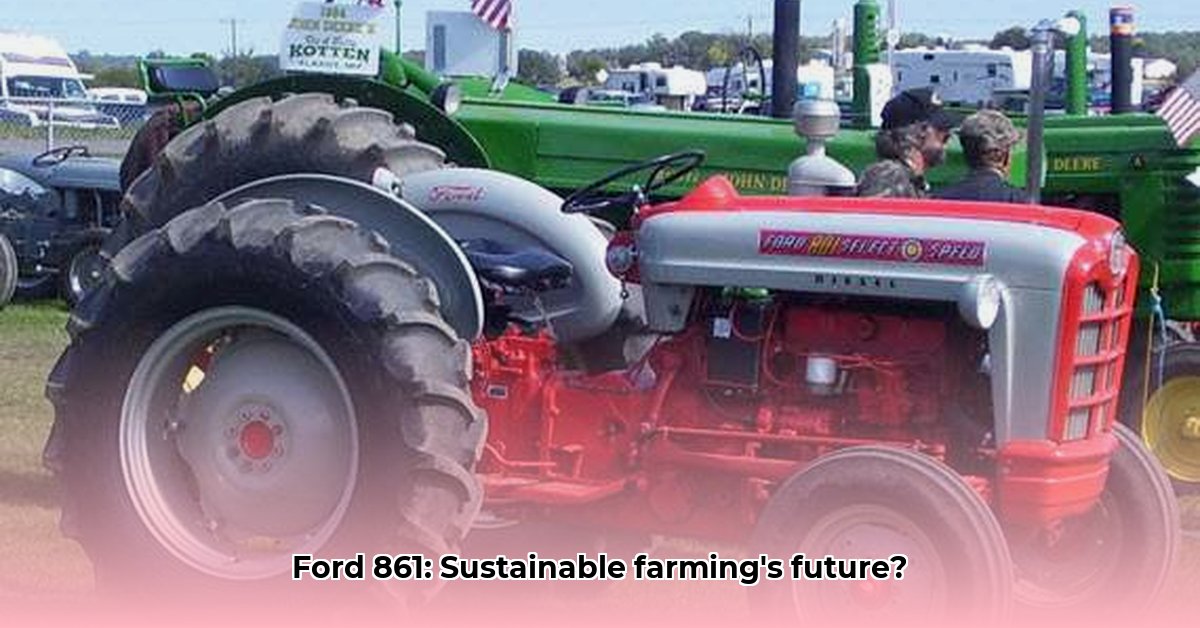
The Ford 861 Powermaster: A Closer Look
The Ford 861 Powermaster, produced between 1958 and 1962, was a workhorse of its time, boasting a 62.6-horsepower engine and a 5-speed, unsynchronized transmission. Its design prioritized simplicity and reliability, features that surprisingly resonate with contemporary sustainable farming practices. For more information on Ford tractor parts, check out this useful resource. While lacking the sophisticated technology of modern tractors, its straightforward mechanics offer potential advantages in maintenance and repair. Could this vintage machine find a niche in today's sustainable agriculture?
Farming in the Late 1950s: The 861's Context
The agricultural landscape of the late 1950s was markedly different from today's. Farming practices were more labor-intensive, and mechanization, while advancing, was not as pervasive. The Ford 861 Powermaster represented a typical technology of this era, providing a dependable, albeit less powerful, solution for farmers' needs. Its design reflected the priorities of the time, focusing on durability and ease of maintenance above all else.
The Ford 861 and Sustainable Agriculture: A Potential Niche?
The Ford 861's simplicity could offer advantages within a sustainable agriculture framework. Its lower horsepower, compared to modern tractors, might translate to less soil compaction – a crucial factor in soil health and nutrient retention. Furthermore, its straightforward mechanical design often leads to easier and potentially cheaper repairs, reducing reliance on specialized dealers and minimizing maintenance costs. While fuel efficiency might be lower per hour of operation than modern tractors, the total fuel used per unit of work completed might be comparable, depending on the specific task and intensity of usage. This deserves further investigation. However, we must acknowledge potential drawbacks. The tractor's lower horsepower results in reduced overall productivity compared to modern counterparts. Parts availability remains a significant hurdle, and regulatory compliance could present challenges. Its lifetime environmental impact, factoring in manufacturing processes and emissions, requires detailed comparative analysis with modern, more efficient equipment. This is an area where more research is urgently needed.
Challenges and Considerations: Real-World Applications
Employing a vintage tractor like the Ford 861 in modern agriculture faces significant practical challenges. Sourcing parts can be problematic, requiring creative solutions like collaborative repair networks or investigating the potential of 3D-printed components. Finding mechanics with the skills to maintain and repair the tractor is another significant obstacle. Furthermore, ensuring compliance with contemporary safety and environmental regulations may require considerable effort and adaptation.
Future Directions: Research and Development
Future research should focus on several key areas. Collaborative repair networks, sharing expertise and resources, could significantly improve parts accessibility. Exploring 3D printing as a viable solution for creating replacement parts should be investigated thoroughly. Crucially, a comprehensive comparison of the total environmental impact (including manufacturing, operation, and end-of-life disposal) of vintage tractors such as the 861 vs. modern tractors is essential for accurate assessment of sustainability. Comparative life-cycle analysis data is critical for a well-informed decision.
Stakeholder Perspectives: Short-Term and Long-Term Goals
Different stakeholders hold varied expectations regarding the Ford 861’s role in modern agriculture.
| Stakeholder Group | Short-Term Goals | Long-Term Goals |
|---|---|---|
| Small-scale Farmers | Evaluate suitability for their operations; Explore local repair options. | Establish reliable repair networks; Secure access to skilled mechanics. |
| Agricultural Historians | Preserve tractors; Collect comprehensive performance and operational data. | Conduct comparative studies with modern tractors; Analyze historical farming practices. |
| Parts Suppliers | Assess market demand; Develop sustainable parts sourcing and manufacturing strategies. | Develop a robust aftermarket supply chain; Investigate sustainable materials. |
| Educational Institutions | Integrate the 861 into agricultural engineering programs; Educate future farmers. | Conduct research on the sustainability of vintage equipment; Provide comparative data. |
Conclusion: A Balanced Perspective
The Ford 861 Powermaster, while offering potential benefits in terms of soil health and potentially lower fuel consumption per unit of work, faces significant hurdles in the context of modern, large-scale agriculture. Its lower productivity, parts availability challenges, and uncertain environmental impact compared to modern alternatives require cautious consideration. However, it could occupy a niche role in small-scale operations or specialized tasks where its simplicity and lower impact on soil might outweigh its limitations. Further research and development are crucial to fully understand and harness its potential within a sustainable farming framework. A holistic approach, considering total environmental impact and lifecycle costs, is essential for evaluating its true position within modern agriculture.